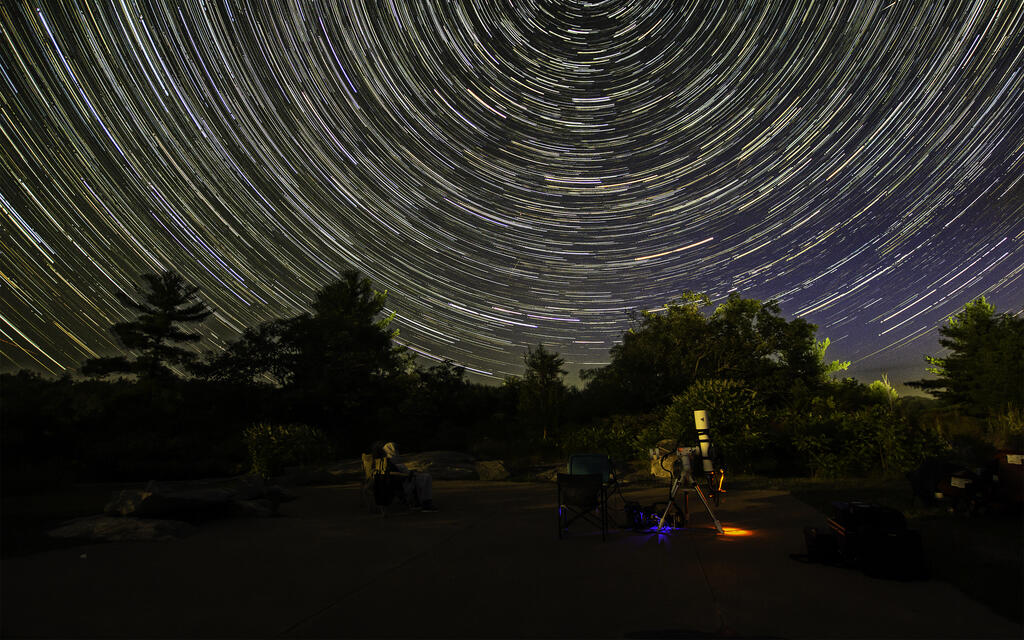There are times of the year when the night sky feels so much more vibrant – the stars brighter, and the darkness – well, darker. In spring, the air is free of air pollution and the sun sets just early enough that you don’t need to stay up past your bedtime to do some stargazing. Even better, there are no mosquitoes!
The attraction to stargazing goes beyond the visual display of sparkling, shimmering, and almost mystical night sky.
In Ontario’s Highlands, we are home to two locations with some of the darkest skies in Ontario – the North Frontenac Astronomy Park and the Lennox & Addington Dark Sky Viewing Area. These spots offer the perfect place to bundle up with a thermos and settle back to drink in the millions of stars overhead, gazing up at the infinite wonder of space.
Why are dark skies important? Light pollution can block out the night skies which can disrupt the flora and fauna in that region. A human’s circadian clock is also dependent on the ever changing rhythm of day and night and the loss of dark skies can affect our sleep.
See the Darkest Skies
Choose from two dark sky preserves in Ontario’s Highlands. Bring a thermos of something to keep you warm, a lawn chair, blanket, and telescope or camera if you have one. If not you can enjoy the show just by tipping back your head and drinking in the night sky.
North Frontenac Dark Sky Preserve: This preserve is located south of Plevna and is known for its phenomenally dark skies set amongst the rugged Canadian shield of North Frontenac. There is an on-site parking area washrooms, and a concrete pad where you can set up a telescope (or a lawn chair).
Lennox & Addington Dark Sky Viewing Area: The Dark Sky Viewing Area is just south of Bon Echo Provincial Park, a location with some of the darkest skies in Ontario and a viewing experience similar to that which was available more than 100 years ago. The Viewing Area had some improvements made over the past year, that includes an expanded concrete platform and solar power for telescope and power equipment. They host many astronomy events each year.
Keep the night skies dark at home with these responsible lighting practices:
- Avoid outdoor lighting (including solar lighting for patios and camp lights)
- Turn off lights when not in use
- Use red lighting when outdoors as it does not disrupt night vision
Note there is a total solar eclipse taking place April 8, which will take place during the day. A solar eclipse takes place as the moon aligns perfectly between the Earth and the sun. It is important NOT to look directly at the sun during a solar eclipse to prevent partial or complete loss of eyesight.
Celestial Events to Watch For
Visiting a dark sky area on an evening when there is an expected celestial event can offer some fabulous night sky viewing, particularly when the skies are clear and the moon is at its darkest. Plan to visit a dark sky area in April and May in time for these events:
- March 29: New Moon: A new moon is the first lunar phase when the moon and the sun are aligned, making the moon invisible to the naked eye. This is one of the best times to explore faint galaxies and stars as there is no moonlight to interfere with viewing.
- April 21-22: Lyrids Meteor Show: This meteor shower will produce about 20 meteors per hour at its peak April 21 to 22. Expect to see meteors producing fireballs but without the trains that you can sometimes see during a meteor shower. The best viewing will be after midnight and because the moon will be less than 10 per cent full during this shower it won’t interfere with night vision.
- April 25-26: Laser Guided Tour at Lennox & Addington Dark Sky Viewing Area: Get a laser-guided tour of the night sky! The tour takes place on Friday and Saturday nights nearest a new moon. The tour begins an hour after dusk and takes roughly an hour.
- April 27: New Moon: A new moon is the first lunar phase when the moon and the sun are aligned, making the moon invisible to the naked eye. This is one of the best times to explore faint galaxies and stars as there is no moonlight to interfere with viewing.
- May 3-5: Eta Aquarids Meteor Shower: Halley’s comet is responsible for the Eta Aquarids meteor shower as it’s produced by dust particles left behind by the comet. The full moon will interfere with the viewing of this shower, but if you are in a dark location after midnight you may still get a good show. Expect to see 30 meteors per hour in the Northern hemisphere.
- May 7: Flower Moon: This full moon is called the “Flower Moon” by Indigenous peoples because this was the time of year when spring flowers first began to unfurl their petals after the long winter. When the moon is full it’s a good time to get a closer look at its surface through telescope or even camera.
- May 26: New Moon: A new moon is the first lunar phase when the moon and the sun are aligned, making the moon invisible to the naked eye. This is one of the best times to explore faint galaxies and stars as there is no moonlight to interfere with viewing.
- May 30-31: Laser Guided Tour at Lennox & Addington Dark Sky Viewing Area: Get a laser-guided tour of the night sky! The tour takes place on Friday and Saturday nights nearest a new moon. The tour begins an hour after dusk and takes roughly an hour.



